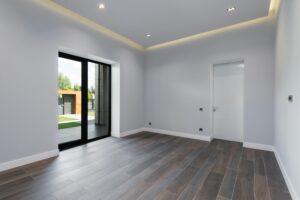Plastering vs. rendering is a common topic in construction, often confusing for homeowners and builders alike. Both are used to coat walls, but the key difference lies in their purpose. Plastering is mainly for interior walls, creating a smooth, paint-ready finish, while rendering is used on external walls to protect them from weather conditions and improve their appearance.
Plastering adds durability and aesthetic value to internal walls by creating a clean, flat surface ideal for painting or decorating. It can also help regulate indoor humidity by absorbing and releasing moisture. Rendering, on the other hand, serves as a protective layer for external walls, shielding them from damage caused by rain, wind, and other environmental factors. Additionally, it offers a decorative touch to the outside of buildings, enhancing their curb appeal.
The materials used for plastering and rendering differ due to their specific applications. Plaster is usually made from gypsum, lime, or cement, providing a fine, smooth finish suitable for indoor use. In contrast, render is typically a mix of cement, sand, and lime, designed to withstand harsh weather and give a coarser finish suitable for external walls.
In this article, we’ll break down the differences between plastering and rendering, the materials used for each, and how to choose the right method for your project. Whether you are focusing on the interior or exterior of your property, understanding these plastering vs. rendering differences will help you make the best decision.
Plastering: What It Is And When To Use It
Plastering is the process of applying a smooth layer of plaster to interior walls and ceilings. The primary function of plastering is to create a flat, even surface that can be painted or decorated, enhancing the aesthetics of a room while also adding durability. Plastering is commonly used in new builds and renovation projects to ensure that internal walls are not only visually appealing but also protected from everyday wear and tear.
What is plastering? Plastering involves spreading plaster—a mixture of water, gypsum, lime, or cement—over surfaces to create a smooth finish. Once the plaster sets and dries, the walls are ready for further decoration, such as painting or wallpapering. Gypsum plaster is often the most popular choice for interior use because it dries quickly and is easy to work with. Other types of plaster, such as lime plaster, are used in older buildings where moisture control is important.
When should plastering be used? Plastering is typically applied to interior walls and ceilings to create a smooth, finished surface. It is essential for new construction projects, but it’s also commonly used in home renovations to repair damaged walls, cover up uneven surfaces, or replace outdated plaster. Plastering is ideal for homes that need an updated look, as it provides a clean and smooth canvas for decorating.
Benefits of plastering: Plastering offers numerous benefits beyond just a smooth finish. Plaster adds an extra layer of strength to walls, helping them withstand wear and tear over time. It also has insulating properties, helping regulate indoor temperatures by retaining heat in the winter and keeping rooms cooler in the summer. Additionally, plaster can absorb and release moisture, which is helpful for controlling indoor humidity levels.
Types of plaster materials: Depending on the project and the type of wall being worked on, different plaster materials may be used. Gypsum plaster is popular for most modern homes because of its ease of application and quick drying time. Lime plaster, though more labour-intensive, is ideal for older homes that need a breathable finish to prevent moisture build-up. Cement plaster is another option, though it’s less commonly used for interiors and more often applied to external walls.
Why hire professionals for plastering? While plastering may seem like a simple task, achieving a smooth, long-lasting finish requires skill and experience. Professional plasterers know how to properly prepare the surface, apply the plaster evenly, and ensure that it sets correctly. Poorly applied plaster can lead to cracks, uneven surfaces, or peeling, all of which will require future repairs.
Plastering is an essential step in finishing or renovating interior walls and ceilings. It offers both aesthetic and practical benefits, making it a critical part of any building or renovation project. By choosing the right materials and ensuring a professional application, you can enhance the appearance and durability of your home’s interior surfaces.
Rendering: What It Is And When To Use It
Rendering is the process of applying a protective layer of material, usually a mixture of sand, cement, and lime, to the external walls of a building. Unlike plastering, which is used inside, rendering serves both functional and aesthetic purposes for external walls. It protects the building from weather damage and enhances the overall look of the structure by giving it a clean, finished appearance.
What is rendering? Rendering is similar to plastering in its application, but it is used on the exterior surfaces of buildings to protect them from the elements, such as rain, wind, and temperature changes. The most common materials used in rendering are sand and cement, which create a durable and weather-resistant coating. There are also modern alternatives, such as acrylic or silicone renders, which are more flexible and crack-resistant.
When should rendering be used? Rendering is typically applied to external walls to protect them from harsh weather conditions. It is especially useful in areas like Portsmouth, where the coastal climate can cause significant wear and tear on buildings. Rendering not only protects the structure from moisture, wind, and salt but also adds a decorative finish that can improve the aesthetic appeal of the property. Many homeowners choose to render their external walls to cover unattractive brickwork or to give an older building a modern facelift.
Benefits of rendering: One of the primary benefits of rendering is the protection it offers to the external walls of a building. It acts as a barrier against rain, which can otherwise seep into the brickwork and cause damp problems inside the property. Render also provides thermal insulation, helping to keep the building warmer in the winter and cooler in the summer. This, in turn, can reduce energy bills by making the building more energy-efficient. Additionally, rendering improves the appearance of the exterior, allowing homeowners to choose from a variety of finishes and colours to suit their style.
Types of rendering materials: Traditional render, made from sand, cement, and lime, is the most common option. However, modern materials such as acrylic and silicone renders are becoming more popular due to their increased flexibility and resistance to cracking. Acrylic render is known for its strong adhesive properties, while silicone render offers superior water resistance and is often self-cleaning, making it a low-maintenance option. These modern materials are ideal for areas prone to extreme weather, as they are less likely to suffer from wear and tear over time.
Why hire professionals for rendering? While it might seem tempting to attempt rendering as a DIY project, it’s a highly skilled task that requires experience and precision. Professionals can ensure that the render is applied evenly and securely, avoiding common mistakes such as cracking or peeling. They also know how to properly prepare the surface and select the right materials for the building, ensuring long-lasting results. Poorly applied render can not only look unsightly but also fail to protect the building, leading to potential water damage and costly repairs.
Rendering is essential for protecting external walls and enhancing the appearance of a property. It provides a strong defence against weather damage, improves thermal insulation, and can significantly boost the curb appeal of a building. By choosing the right materials and hiring professional renderers, you can ensure that your property is well-protected and visually appealing for many years to come.

Plastering Vs. Rendering: Choosing The Right Materials
When it comes to deciding between plastering and rendering, selecting the right materials is crucial to ensuring a long-lasting and effective finish. Both processes involve applying a material to walls, but the type of material used will differ depending on whether you are working on an interior or exterior surface. The choice of materials impacts not only the durability of the finish but also its appearance, insulation properties, and resistance to wear and tear.
Materials for Plastering: Plastering materials are specifically designed for interior use, offering a smooth and decorative finish. The most common types of plaster include gypsum, lime, and cement-based plasters, each with their own advantages. Gypsum plaster is the most widely used for interior walls because it dries quickly and provides a smooth, paint-ready surface. It’s also easy to work with and ideal for most modern homes. Lime plaster, on the other hand, is often used in older buildings where moisture control is important. Lime is a breathable material that allows moisture to evaporate, preventing dampness. Cement-based plaster is sometimes used when a stronger and more durable surface is needed, though it’s less common for interior work.
Materials for Rendering: Rendering materials, designed for external use, are generally tougher and more weather-resistant than plaster. Traditional render is a mixture of sand, cement, and lime, which creates a thick and durable layer that protects the exterior walls from the elements. It’s ideal for homes in harsh climates or areas with frequent rainfall, such as coastal regions. Cement renders are known for their strength and longevity, but they can sometimes crack over time due to the natural movement of buildings.
In recent years, modern alternatives to traditional render have become popular. Acrylic and silicone renders are more flexible and less prone to cracking, making them perfect for homes in areas with temperature fluctuations or heavy rainfall. Acrylic render is known for its strong adhesive properties, which help it bond well to different surfaces. It also provides a smooth finish and is available in a wide range of colours, allowing homeowners to customise the look of their property. Silicone render, meanwhile, offers excellent water resistance and is often self-cleaning, making it a low-maintenance option. This type of render is ideal for properties that need extra protection from the weather.
When to Choose Plastering Materials: Plastering materials should be used for interior walls and ceilings where a smooth, decorative finish is required. If you’re working on a new build or renovating an existing room, gypsum plaster is the go-to option for most modern homes. However, if you’re restoring an older property, especially one with historical significance, lime plaster might be the better choice due to its breathable properties.
When to Choose Rendering Materials: Rendering materials are essential for exterior walls that need to withstand the elements. For traditional homes, a cement-lime render provides durability and protection, while for modern buildings or areas prone to harsh weather, acrylic or silicone renders are excellent choices. These modern materials not only protect but also enhance the appearance of a property, with their flexible nature reducing the risk of cracks and other issues.
The choice between plastering vs. rendering materials depends on whether you’re working on the interior or exterior of a building and the specific needs of the project. By selecting the right materials, you can ensure a durable, attractive finish that enhances both the function and aesthetic of your property.

How To Choose Between Plastering And Rendering For Your Project
Deciding between plastering and rendering depends on the specific needs of your project, as both techniques serve different purposes and are suited for different environments. Understanding the key differences between the two and knowing when to use each will help you achieve the best results for your property.
- Location of the Surface: The most significant factor when choosing between plastering and rendering is whether the surface is internal or external. Plastering is exclusively for interior walls and ceilings, providing a smooth, finished surface that’s ready for decorating. Rendering, on the other hand, is used on external walls, offering protection from the elements while enhancing the building’s curb appeal. If you’re working on interior walls, plastering is the right choice. For external walls, rendering is essential to guard against weather damage and provide insulation.
- Purpose and Functionality: Another key consideration is the purpose of the coating. Plastering is meant to create a flawless finish for interior walls, hiding any imperfections and creating a clean, even surface. It also adds a level of soundproofing and thermal insulation to indoor spaces. Rendering is more focused on protection—especially from environmental factors like rain, wind, and extreme temperatures—while also providing a decorative finish to external walls.
- Type of Property: The age and style of the building can also play a role in your decision. Older, historical properties may require lime plaster or lime-based render to maintain their structural integrity and manage moisture, whereas modern properties can benefit from newer materials like gypsum plaster indoors and acrylic or silicone render outdoors for added flexibility and protection.
Ultimately, choosing between plastering and rendering depends on the location, function, and type of property you’re working with, ensuring that both internal and external surfaces receive the care and finish they require.
Choosing The Right Materials For Plastering And Rendering
When deciding between plastering and rendering, it’s essential to understand the unique roles each plays in construction and renovation. Plastering is the go-to option for creating smooth, finished internal walls that are ready for decoration. It adds a clean, durable surface that enhances the look of interior spaces. On the other hand, rendering provides crucial protection for external walls, shielding them from harsh weather conditions while also adding aesthetic value to the building’s exterior.
Selecting the right materials for each job is equally important. Gypsum plaster is ideal for most interior work due to its ease of use and smooth finish, while cement, acrylic, or silicone renders are excellent choices for protecting external walls from the elements. For older properties, lime-based materials may be the best solution to ensure breathability and manage moisture.
At EJL Supplies, we offer a wide range of high-quality plastering and rendering materials to suit any project. Our expert team is ready to assist you in selecting the right products to ensure long-lasting results. Whether you’re renovating your home’s interior or upgrading its exterior, we’re here to help. For professional plastering and rendering supplies, visit EJL Supplies or contact us on 02394 007 676 for expert advice on the best materials for your next project!

